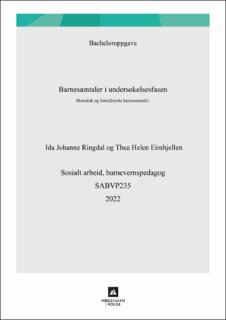| dc.contributor.author | Ringdal, Ida Johanne | |
| dc.contributor.author | Eimhjellen, Thea Helen | |
| dc.date.accessioned | 2022-07-21T11:14:09Z | |
| dc.date.available | 2022-07-21T11:14:09Z | |
| dc.date.issued | 2022 | |
| dc.identifier.uri | https://hdl.handle.net/11250/3007514 | |
| dc.description.abstract | Gjennom 1 år får barneverntjenesten mange tusen bekymringsmeldinger som går til undersøkelse (Barne-, ungdoms- og familiedirektoratet, 2021). Barneverntjenesten er pliktig til å undersøke forholdene omkring bekymringsmeldingen (Barnevernloven, 1992, §4-3). Barnet bør ha en sentral rolle gjennom undersøkelsen. For at barnet skal bli sett, hørt og lyttet til, må kontaktpersoner i barneverntjenesten utføre samtaler med barnet. Gjennom en kvalitativ studie har vi satt søkelys på hvordan kan kontaktpersonen i barnevernet oppnå gode barnesamtaler i undersøkelsesfasen?
For å undersøke dette foretok vi fire individuelle dybdeintervju med kontaktpersoner som arbeider i undersøkelsesfasen. Erfaringene de fortalte oss om, ga oss kunnskap om hvordan barnesamtaler utføres i undersøkelsesfasen. Sentrale funn er at kontaktpersonene har en egen kontaktetableringsfase, og anvendender aktiviseringsmateriell, tankelesing og triangulerte samtaler. Funnene vektlegger at kontaktpersonen bør ha en nysgjerrig og anerkjennende holdning ved samtalene.
Ved siden av å opptre anerkjennende og nysgjerrig, viser kontaktetableringsfasen seg å være er sentral. Disse momentene viser seg imidlertid som særlig utfordrende å gjennomføre ved mangel på tid. Det å gi tilstrekkelig og forståelig informasjon viser seg å være viktig for å trygge barnet. Kontaktpersonen kan triangulere inn barnets omsorgsgivere for å øke sannsynligheten for at barnet forstår informasjonen. I undersøkende samtaler kan anvendelse av aktiviseringsmateriell være nyttig, både for å trygge barnet, men også for å utvide dets uttrykksmulighet. Vi diskuterer også hvorvidt tankelesing kan fungere som anerkjennende eller begrensende for barnet.
Oppgaven belyser viktigheten av at samtalene har tydelige formål, og at metodene kontaktpersonen anvender bør være tett knyttet til dette. Tilstrekkelig og tilpasset informasjon øker barnets forståelse av situasjonen og gjør det tryggere. At barnet er trygg er en av forutsetningene for gode samtaler. I starten av arbeidet kan en kontaktetableringsfase være nyttig. Aktiviseringsmateriell kan fungere positivt på både barnets mulighet til å kunne uttrykke seg fritt og dets trygghet i samtalesituasjonen. Tankelesing var er en metode som kan bidra positivt i kommunikasjonen, men det kan også virke hemmende. | en_US |
| dc.description.abstract | Abstract
The child welfare service receives several thousand messages of concerns yearly for examination (Barne-, ungdoms- og familiedirektoratet, 2021). Furthermore, they are also obligated to examine the environment surrounding these concerns (Barnevernloven, 1992, §4-3). The child should have a central role during the examination. In order for the child to be seen and heard, points of contact within the child welfare service must conduct conversations with the child. Through a qualitative study, we have focused on how the point of contact in the child welfare service can achieve good conversations with the children during the examination phase.
To pursue this question further, four individual depth interviews were conducted with people working as points of contact in the examination phase. The experiences they shared gave us knowledge of how children conversations are conducted during this phase. Main findings indicate that the points of contact have their own procedure of contact establishment, utilizing activity methods, mind reading and triangulated conversations. The findings substantiates the fact that the point of contact should have a curious and appreciative attitude during the conversations.
Alongside acting appreciative and curious, the contact establishment phase proves to be central. These factors does appear challenging to perform though, mainly due to lack of time available. Giving sufficient and understandable information shows to be important for the child to feel safer. In order to raise the probability for the child to understand the information, the point of contact can include the child’s caretakers. During examination conversations, utilization of activity methods can be useful, both for ensuring that the child feel and safer and expand its expression opportunities. We will also discuss to which extent mind reading could act as appreciative or limiting for the child.
The thesis highlights the importance of the fact that the conversations have concrete purposes, and that the methods in which the points of contact utilizes must be closely related to this. Sufficient and adapted information increases the child’s understanding of the situation, along with the feeling of safety. The child’s safety is one of the main prerequisites for good conversations. A contact establishment phase can be useful in the beginning of the process. Activity methods can have a positive influence on the child’s possibility to express itself freely while feeling safe in the conversation. Mind reading is a method that can contribute in the communication, but it could also act inhibitory. | en_US |
| dc.language.iso | nob | en_US |
| dc.publisher | Høgskulen i Volda | en_US |
| dc.title | Barnesamtaler i undersøkelsesfasen. Metodisk og formålstyrte barnesamtaler | en_US |
| dc.type | Bachelor thesis | en_US |
| dc.source.pagenumber | 46 | en_US |
